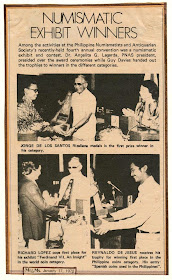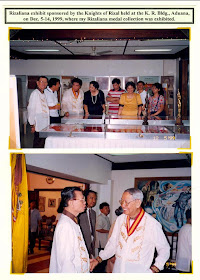MEDALLIC RIZALIANA
By Jorge T. delos Santos
A hero for all seasons, Jose Rizal embodies not only the best qualities of his race and people but also the greatness of his nation. Admired as a martyred libertarian, he was also a peerless journalist and gifted writer, poet, linguist, agriculturist, physician, ophthalmologist, engineer, sculptor and artist – truly, a Universal Man. Hence, Rizal richly deserves the supreme accolade heaped upon him by his grateful and admiring countrymen. It is, therefore, not at all surprising that Rizal was honored even during his lifetime by the revolutionary organization, the KATIPUNAN, a sector of which called “Bayani” had for its password the name “Rizal”. The different councils or sections set up by the Katipunan in various parts of Manila and environs were given symbolic names. The one established at Trozo, Manila was called Dapitan (after Rizal’s place of exile). And as an inspirational light of the secret society, Rizal without his knowledge ,was chosen the honorary President.
After Rizal’s execution on December 30, 1896, the wide acclaim accorded him gained even greater intensity and fervor. As he preferred reforms over revolution, some sectors believed that the Americans had favored him over other Filipino heroes with revolutionary bent for they considered him the safest symbol of the Filipinos’s rising nationalism at that time and thus allowed and even encouraged his popularity to grow to unprecedented heights. This, of course, is a misconception as the choice of Rizal as our National Hero was then and even now generally accepted by the overwhelming majority of Filipinos who, according to Leon Ma. Guerero, “love peace, freedom and justice”, and “reserve their highest homage and deepest love for the Christ-like victims whose mission is to consummate by their tragic failure the redemption of our nation”
From the halcyon days of the American colonial rule to the Commonwealth era, and even during the troubled years of the Japanese Occupation, Rizal Day was religiously observed on two occasions, Rizal’s birth and death anniversaries. However, the December 30 celebrations were gala and elaborate affairs complete with programs, oratorical and beauty contests, civic parades, and floats vying with one another in their colorful designs and nationalistic symbolism. Expected to be in attendance were the national and local officials, community leaders, teachers and students.
After the Liberation, these celebrations lost much of their gaiety and color having become more subdued and sober affairs observed throughout the country by simple ceremonies, consisting mostly of raising of the flag, singing National Anthem, laying wreath before Rizal’s monument and brief program with the usual speeches being delivered by local officials.
Of course, this year marked the 150th Birth Anniversary of Rizal last June 19.
Obviously these historic events merited permanent recording for posterity.. And what better means to preserve memories of these events with patriotic significance than by issuing commemorative medals on their anniversaries? Thus Rizal medals were struck almost annually in silver, bronze, gilt but rarely in solid gold. Unidentified engravers struck some but many carried the names of the more popular ones like Crispulo and Luis Zamora, C. Valdez and El Oro.
As far as is known, the earliest Rizaliana medal was issued in late 1901, five years after Rizal’s execution. Struck in bronze and having a diameter of only 22mm. the miniature medal had the bust of Rizal on the obverse and the inscriptions “Al Ilustre Patricio Filipinas/Doctor Jose Rizal/Manila/30 December (sic) 1901” at the reverse. A variety of this tiny medal was struck the same year in bronze but it was uniface and only the reverse of the other medal appeared on its face.
 |
| Solid Gold Rizal Day Medal issued in 1906 |
Rizal medals of varying sizes, shapes and designs were minted during the succeeding years, some of them bearing the Rizal monument on their obverse. Those appearing during the American regime particularly in 1907, 1909, 1910, 1914, 1916, 1918 and 1920 are worth mentioning in view of their eye-caching appeal which must have required a lot of imagination and aesthetic sense on the part of the engravers concerned. It was, however, in 1906 that a solid gold medal was struck for the first time, along with the usual silver and bronze issues. Depicting the Rizal bust on the obverse and measuring 31.5 mm. the reverse had these inscriptions: “Procesion Civica/Rizal Day/1906/Fiipinas”
During the Japanese Occupation, the only medals issued honoring Rizal was a set of three struck in silver, bronze and gilt. An extremely scarce issue, it was minted in 1943 on the occasion of the Exhibit of Rizal’s Writings in the Tagalog Language. The obverse portrayed the usual bust of Rizal and the years “1861- 1896; while inscribed on the top were words written in "Baybayin", an ancient Philippine form of writing.
The traditional minting of these medals contributed without let-up, but it was during the Birth Centenary of Rizal in 1961 that a bumper harvest of them were struck in practically all types of metals to the sheer delight and approval of medal collectors particularly those specializing in Rizaliana. Seriously involved in this competitive enterprise were the national and local governments, civic and socio-economic organizations, universities and schools, corporations and even private individuals.
Easily the most outstanding and rarest Rizal medal minted in the 1961 Centennial Year was that designed by famous sculptor Guillermo E. Tolentino, a National Artist. This particular commemorative medal was awarded to the first three prizewinners in the international competition sponsored by National Centennial Commission. Three were struck in Italy, one each in gold, silver and bronze. The size is 57mm. Its obverse had the bust of Rizal facing right as well as the inscription “Centenary of Dr. Jose Rizal/ June 19, 1861/ June 19, 1961”. Below the date “June 19, 1961” is the sculptor’s name in very small letters. Appearing at the reverse is Rizal’s well-known sculpture “The Victory of Science over Death”, while on its two sides are listed down in minute letters Rizal’s numerous virtues, accomplishments and versatility.
A very prolific contributor to the growing list of Rizal medals in the country is the Order of the Knights of Rizal, a socio-civic organization whose aims, among others, are to study, promote and propagate the teachings of Rizal and to preserve, honor and revere his memory. A regalian requirements of the organization is for the newly inducted members and officers to wear Knight of Rizal medals as part of their ceremonial uniforms. The Society and its numerous chapters throughout the country are also responsible for the issuance of varying types of Rizal medals not only to call attention to the twin anniversaries of the hero but also to commemorate certain important events in the life of the Society.
 |
| Rizal's Pro Patria Medal |
Very much coveted by the citizenry is the Rizal Pro Patria medallion. Government awards this to citizens and institutions who gained recognition for their distinguished and outstanding contributions to the advancement of national progress, stimulation of the love of country and civic citizenship, and responsibility to the general community and the Republic. Obverse of the medallion has Rizal’s bust facing left and legend with two circular lines (blue enamel) PRO PATRIA above and JOSE RIZAL below; while the reverse in blue enamel is the seal of the Philippine Republic. Large in size, it measures 85mm., and is struck in gilt bronze.
More Rizal medals and related memorabilia became available to collectors in 1996, which marked the hero’s death centenary.
Noted pre-war Filipiniana collectors had specialized in Rizaliana medals, the more prominent ones being the late Antonio Bantug, Don Pablo Esperidion, Dr. Mena Crisologo, Dr. Jesus Celis and Don Pablo de Jesus.
Those desiring to specialize further in these medals will find the following publications and articles very helpful:
1. “Coins, Medals and Tokens of the Philippines 1728- 1974”, Second ed. (1975), by Aldo Basso.
2. “Jose Rizal in Numismatics” by Dr. Mena Crisologo published in the U.S. magazine, “The Numismatist” issues of December 1961 and March 1966.
3. “Rizal in Medallic Art” by Jose J. Tupaz, Jr., published in the Philippine Numismatic Monograph, issue of December, 1956.
The list of these medallic issues continues to grow longer every year, hence, an updated and more comprehensive catalogue will certainly be appreciated and welcomed by collectors
 |
| Various Rizaliana Medals |
 |
| Various Rizaliana Medals |
 |
| Various Rizaliana Medals |
 |
| Various Rizaliana Medals |
 |
| Various Rizaliana Pins and Amulets |
 |
| Rizal's Death Anniversary Medals |
 |
| Rizal's Death Anniversary Medals |
 |
| Knights of Rizal Medals |
 |
| Knights of Rizal Medals |
 |
| Knights of Rizal Medals |
 |
| Various Rizaliana Medals |
 |
| Various Rizaliana Medals |
 |
| 1896-1951 PNAS Jose Rizal's 55th Death Anniversary |
 |
| 1896-1946 Quinquagesimo Anniversario Dia De Rizal |
 |
1951 CABALLEROS DE JOSE RIZAL (Order of the Knights of Rizal) Philippine Medal |
 |
| 1961 Jose Rizal National Centennial Commission Philippine Medal |

















Great stuff. Regarding the "RIZAL Japanese Occupation Medal issued in 1943", it's not Sanskrit but our very own ancient writing system called Baybayin. I'd like to feature it in one of my presentations (with credit of course). Hopefully I can find one of these
ReplyDeleteThanks for your comment Christian. I will make the proper corrections.
ReplyDeletesir ask ko lang po if your interested sa "filipiniana " or old books written by jose
ReplyDeleterizal pls contact 09998068643 look for cherrie thanks po
Sir ask ko lang po kung may mga auction or antique shops na alam ninyo na may Rizal Medal Collections?
ReplyDeleteSir I have one medal of Jose Rizal's Heritage and Posperity award
DeleteI have 5 Jose Rizal medal dated 1968 and 1961
DeleteI welcome messages and comments at my "Pinoy Kollektor" Facebook
DeleteVisit Bayanihan Collectors Club' Facebook account to know their auction schedules, sometimes they have Rizaliana medals for sale.
ReplyDeleteWonderful collection sir! ginagamit ko din po ito for reference:)
ReplyDeleteMeron po akong medalla de honor malabon rizal 1911 na medal pure silver
ReplyDeleteHm mo sell sir
Deletecontact me on Facebook - Pinoy Kollektor
DeleteHM kuha MU Sir SA Rizal medal 1905 Yung may sumbrero sya
DeleteAko mayron 1951 medal
ReplyDelete